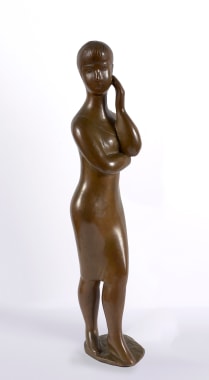
William Zorach emigrated from Lithuania to Cleveland, Ohio, with his family in 1892. At the age of thirteen, he was encouraged by a teacher to take lithography classes at the Cleveland School of Art in the evenings, and soon after, he began to apprentice at a Cleveland lithography company. By 1907, the young artist had saved enough money to move to New York in order to study at the National Academy of Design.
In 1910, Zorach traveled to Paris, where he studied under Jacques-Emile Blanche at La Palette and where several of his paintings were included in the 1911 Salon d’Automne, the annual exhibition for young artists. While there, he was exposed to Cubism and Fauvism that greatly influenced his work as well as that of California artist Marguerite Thompson. The two married when they returned to New York in 1912, and both their works were included in the landmark Armory Show of 1913 as well as in the important 1916 Forum Exhibition of Modern American Painters at the Anderson Galleries. From 1915-1917, William and Marguerite had three exhibitions together at the Daniel Gallery, and William also showed at the Whitney Studio Club and the Society of Independent Artists. Their time in Paris, inclusion in the Armory and Forum exhibitions, and friendship with the artist Max Weber, whom they met in 1915, contributed to the influence of Cubism on both artists’ work, allowing the exploration of Abstraction and manipulation of form and perspective.
In 1922, William began to focus his time and efforts on sculpture, transitioning his interest in Abstract and Cubist forms from painting to three-dimensional wood, stone, and bronze objects.
He was soon recognized as one of the country’s premier sculptors, honored with multiple commissions throughout the country and exhibitions at the Art Institute of Chicago, the Dallas Museum of Fine Art, the McNay Art Museum, and the Whitney Museum of American Art. In 2017, Zorach was included in A New American Sculpture, 1914-1945: Lachaise, Laurent, Nadelman, and Zorach at the Portland Museum of Art and the Amon Carter Museum of American Art.
